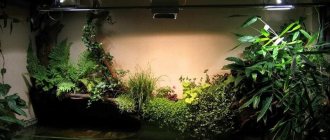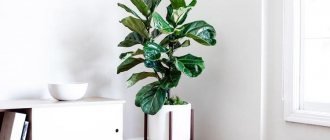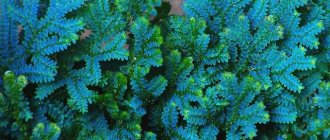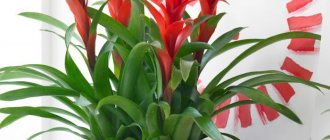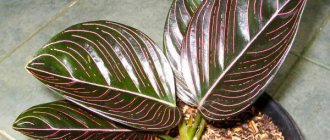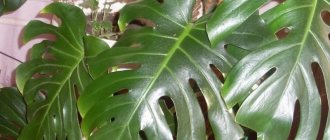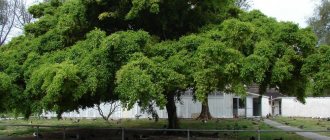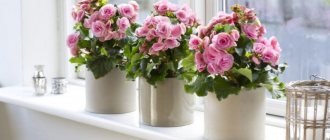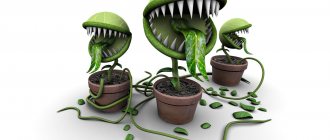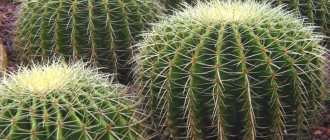Red fruits resemble dogwood in appearance and taste
Aucuba is a flower that is used to decorate office spaces and home window sills. This houseplant first appeared in Europe in 1783 - it was brought from the humid subtropics of eastern Asia. According to the latest data from scientists, the flower belongs to the garriaceae family; previously it was classified as a dogwood. In nature, it is a small bush or tree with large green leaves speckled with yellow. Due to the abundance of this pigment, aucuba was popularly called the “golden” or “sausage” tree. The last name was apparently given to it by the original gourmets, since the golden circles on the oblong leaves reminded them of sliced pieces of sausage. Residents of Europe were delighted with the evergreen beauty and quickly adopted it as decoration both in their gardens and in their homes.
Beautiful large leaf crop with a scattering of yellow spots of various sizes
Indoor flowers with decorative leaves (names and photos)
Below are a variety of flowers with decorative leaves and excellent aesthetic properties.
There is plenty to choose from for your floral arrangements. Aeonium
with rosettes of fleshy leaves they look very attractive. Depending on the species, leaf rosettes are located directly on the ground (Aeonium tabuliforme) and on a more or less high trunk (Aeonium arboreum, A. canariense, A. haworthii). The color of the leaves and their shape also vary depending on the species and variety.
Look at these flowers with decorative leaves in the photo, which shows the different stages of plant development:
Family. Crassuiaceae (Crassulaceae).
Homeland. Canary Islands, Morocco.
Location. Sunny, a lot of light. The south window is perfect.
Temperature. Tolerates high room temperatures, but not lower than 10 °C.
Air humidity. Doesn't matter.
Substrate. 1/3 of flower soil mixture, loam and sand or perlite.
Watering. Only to maintain constant moisture in the earthen coma. During the rest period there is very little.
Feeding. Apply cactus fertilizer every 2 weeks.
Transfer. Once every 2 years.
Reproduction. Apical or leaf cuttings.
Pests, diseases. Rarely.
Important! Aeonium tabuliforme dies after flowering. Make sure that the leaves do not dry out from lack of moisture, otherwise the plant will die.
Japanese aucuba (golden tree) Aucuba japonica
Only Aucuba japonica is suitable for the room, a shrub up to 2 m in height with oval large leathery leaves, which in Aucuba japonica variety 'Variegata' are distinguished by golden inclusions, in Aucuba japonica 'Crotonifolia' are half green and yellow, and in 'Goldieana' - yellow in middle.
Family. Sogpaseae (Dogonels).
Homeland. Japan, Korea. Location Light.
Temperature. Not higher than 24 °C.
Air humidity. In warm rooms, sensitive to dry air.
Substrate. Flower soil mixture.
Watering. Abundant.
Feeding. Every 4 weeks. During cool winters, do not fertilize.
Transfer. If necessary, adult plants are rare.
Reproduction. Apical cuttings in spring.
Pests, diseases. Scale insects.
Important! In summer, place outdoors in partial shade. If the plant has become too large, it can be transplanted into a tub
Carefully! Eating berries can cause fever and vomiting
Look at these flowers with decorative leaves in the photo and the name will be completely justified, since it is given by appearance:
Carefully! Eating berries can cause fever and vomiting. Look at these flowers with decorative leaves in the photo and the name will become completely justified, since it is given by appearance:. Look at these flowers with decorative leaves in the photo and the name will be completely justified, since it is given by appearance:
Look at these flowers with decorative leaves in the photo and the name will be completely justified, since it is given by appearance:
Ceropegia
On thread-thin shoots up to 2 m long, small fleshy leaves are formed at significant intervals, with silvery spots on the upper side and red spots on the lower side. Flowers appear from the leaf axils in autumn.
In specimens of the most common type of Wood's ceropegia (Ceropegia woodii), and there are over 150 species in total, aerial tubers are formed on the shoots, which are used for propagation. Ceropegia is an excellent hanging plant.
Family. Asclepiadaceae (Lastovnevye).
Homeland. Africa, Asia.
Location. Sunlight, but not direct midday rays.
Temperature. Room, not lower than 8 °C.
Air humidity. Not significant.
Substrate. Flower soil mixture with 1/3 sand.
Watering. The substrate should be constantly moist in summer and dry in winter.
Feeding. During the growth period every 4 weeks.
Transfer. Once every 2 years.
Reproduction. Nodules or shoot cuttings.
Pests, diseases. Rarely.
Look at these indoor flowers with decorative leaves in the photo, where all the described botanical characteristics are attached:
Home flower with colorful leaves peperomia
Peperomia grow slowly and are suitable for places where space is limited. The inflorescence is a thin vertical spike covered with tiny greenish flowers. There are several hanging species, but bush ones with different leaf shapes and colors are more popular. Growing peperomia is not difficult.
Peperomia has corrugated leaves 2.5 cm wide; P. hederaefolia has wavy leaves 5 cm wide; P. magnoliaefolia Variegata has variegated waxy leaves measuring 5 cm.
Temperature: Moderate - minimum 10°C in winter.
Light: Bright light or partial shade without direct sunlight.
Watering: Allow the soil to dry out somewhat between waterings - water very sparingly in winter.
Humidity: Spray foliage occasionally in summer and never in winter.
Repotting: Repot in spring only if necessary.
Reproduction: By stem cuttings in spring.
Indoor rare flowering curiosities
Flower growers, lovers of growing exotic plants and surprising friends and strangers with them, always want to have rare and unusual plants in their collection. These enthusiasts never tire of looking for unusual flowers, not so common with an original appearance, without even fearing the possible difficulties of growing.
But the beautiful representatives of the plant world, which are compared to jewels, deserve to be given a little more attention when growing than other flowers that are not so whimsical.
Lachenalia aloe vera is the only flower out of 90 species that is grown as an indoor plant, decorative flowering, and has a very aesthetic appearance. The flower has wide, pleasant green leaves with speckles, tall peduncles, loose inflorescences with bell-tubes of yellow and red colors, sometimes multi-colored flowers are found. Lachenalia is especially pleasing because it blooms in the depths of winter, when there is such a shortage of bright colors.
Lachenalia aloeides
It will bloom brightly and for a long time if you place it on a frost-free loggia, where the temperature does not fall below 50 C; at temperatures above 200 C, leaves actively grow and the flowers lose their saturation.
Columnea is a magnificently flowering climbing plant, quite rarely found in houses and apartments, although the beauty of its flowers, somewhat similar to orchids, easily outshines other indoor plants.
It belongs to the epiphytes, preferring to live in trees in natural conditions; in indoor conditions it is grown as an ampelous flower. Considered capricious when caring for her:
- diffused lighting is best;
- does not tolerate lime water, only filtered or distilled water should be used;
- Stagnation of water should not be allowed;
- Systematic irrigation is necessary, especially in the heat; at low air humidity, it sheds its leaves and does not bloom.
The flower is also susceptible to attack by spider mites and whiteflies; the column needs to be periodically inspected in order to identify pests in time.
Strelitzia regal - with its bright, unusual flower shape, it resembles a bird of paradise. In order to compensate for moisture, the excess of which the root system cannot tolerate, Strelitzia is constantly sprayed with warm water. Even in winter, when watering is not needed, wipe the plant with a damp cloth.
Strelitzia reginas
Takki is a representative of perennial tropical plants, for lovers of exotics it is a valuable option for mysterious flowers, it is very rarely found on sale, it is difficult to grow from seeds, but unusual flowers with a purple tint find their fans who manage to grow such a rare color in their homes.
Takki
Rules of care
Decorative foliage indoor plants require careful attention. If everything is done correctly, they will decorate the room for a long time.
Water treatments
Absolutely any plant needs water. And while in the wild many species can make do with moisture extracted from the depths, this option is unacceptable for a potted culture. It is necessary to carefully understand how drought-resistant a particular species is. The most delicate crops require extremely regular care. The slightest causeless deviations from the schedule are strictly unacceptable.
But this does not mean that you can overwater your plants. The intensity of irrigation depends on both the time of year and the actual temperature.
Important: in addition to the formal schedule, you need to take into account the actual humidity of the earth's surface. When it dries, you can water it immediately, but not before
Spraying
But we must also take into account the need to use spray guns. This procedure simulates rainfall and thereby brings the living conditions closer to the natural norm. You will definitely have to spray:
- all plants imported from tropical and subtropical regions, from the equator and from the subequatorial zone;
- all crops with fleshy leaves of a rich green tone;
- conifers (regardless of region of origin).
It should be remembered that spraying is strictly prohibited for:
- crops with thin, almost transparent leaves;
- plants with pubescent or velvety leaves;
- lacy, jagged foliage.
Attention: if the decorative foliage crop does bloom, it is advisable to cover the petals and buds for a while. Spraying these parts is strictly prohibited.
Spraying in the dark is also unacceptable, because then water will not be able to participate in the process of photosynthesis. Fine spraying of water is contraindicated for any plants. Very small droplets will simply flow down to the roots, and there will be no result from such a procedure.
If the ornamental crop is located in a place directly illuminated by the sun, it must be moved into the shade during spraying. Return the container back only after the surface of the leaves and trunk has dried. When the cold season sets in, you should not keep the sprayed plant on the windowsill.
At this moment, stable warmth is very important to him. No matter how much time it takes to work, you can’t stop: you need to get water to start dripping from the leaves
Shine of leaves
Lush, shiny foliage is a sure indicator of healthy indoor plantings. And this property does not depend on hydration alone. Of course, proper watering is very important. However, neither this nor even washing the foliage with water from a spray bottle and removing dust solves all problems. Advertising actively promotes all kinds of decorative products.
Some gardeners mindlessly grab them, without even trying to understand what kind of preparations they are using and how good the effect will be. Many decorative foliage plants do not require polishing at all. They should look perfect even without it. Polishing is required, for example, for croton, ficus, monstera, and aspidistra.
Other representatives capable of decorating any room
In addition to the decorative flowering and decorative foliage plants discussed above, there are other categories. Their most beautiful representatives look no worse, and sometimes much more interesting. Thanks to their unusual shape and color, as well as very interesting flowering, they can rightfully be considered one of the most beautiful indoor plants.
Agave
Agave is a large perennial succulent plant. More than 300 species are known, but only a few are grown indoors. Compact types that fit on the windowsill are very popular.
And for decorating large rooms, large varieties with large and brightly colored leaves are suitable.
The stem of the plant is greatly shortened. The leaves are collected in a basal rosette. Agave leaves are hard, elongated, and their ends are pointed. They have sharp spikes along the edges. The most decorative can be considered variegated varieties of agave, the leaves of which have a wide white or cream stripe along the edges.
Pomegranate
Indoor pomegranate is a fruit-bearing plant for indoor spaces, which looks great both during flowering and during the period of fruit ripening.
All varieties of indoor pomegranate are compact so that the plant can be grown without problems even in a small city apartment.
A properly formed tree, covered with small dark green leaves, looks very lush and decorative. Pomegranate blooms profusely. Bright red flowers almost completely cover the plant. After flowering ends, small red fruits are formed, which greatly enliven the tree and give it an unusual appearance.
Orchids
Orchids have long amazed us with their unusually beautiful blooms. These are mostly epiphytic plants growing on the bark of trees with an open root system. In their homeland in tropical Asia, they have adapted to a warm climate and high humidity.
The plants have a short trunk with dense, elongated leathery leaves. Orchid roots are thick and poorly branched. During the flowering period, the plant forms a peduncle on which many amazingly beautiful flowers of unusual shapes bloom. Their shades are very diverse. There are white, pink, red, burgundy, lilac and multi-colored colors.
Precious orchids
These types of orchids are not widespread due to the difficulty of keeping them. They are grown not for flowering, but for their amazingly beautiful leaves. The velvet leaf blades of precious orchids, playing in the sun, are covered with a network of veins, shimmering with a gold or silver sheen.
Jewel orchids are terrestrial plants that, unlike other members of their family, grow well in ordinary soil. But they are adapted to the humid tropical climate of Southeast Asia, so they can only be grown in a florarium.
Sedum
Sedum or sedum is considered one of the most beautiful succulent plants. There are many types of it. Among them there are upright varieties that form clumps, and hanging varieties that look good in hanging pots or flowerpots.
Sedum shoots are strong and easily branched. Their length can reach 30 cm. The leaves of this succulent are cylindrical in shape with a pointed tip. Their color may vary depending on the type of plant. There are silvery, bright green, yellowish and reddish varieties that look amazingly beautiful.
Indoor flowers for children
If there are small children at home, safety comes to the fore, because kids experience the world tactilely, by smell and taste. We have chosen several plants that will be completely harmless to your precious child!
Lemon Tree
Lemon is light, fresh and clean, and its leaves contain beneficial essential oils. It has a pronounced antibacterial effect, and also a subtle pleasant aroma.
Violet
Unpretentious violets create a feeling of warmth and comfort in the room, which is so valuable for children. Flowers and leaves are completely safe, because sometimes the petals are even used to decorate dishes in cooking.
Tradescantia
The flower is not only unpretentious, but also completely harmless, even if a child tastes it. Bright two-color leaves decorate the interior and delight with interesting colors.
Cypress
Children are attracted to the whimsical cypress tree by its unusual shape and texture. It has natural antiseptic properties, so it destroys bacteria and fungi around it.
Peperomia
Peperomia leaves contain healing phytoncides that improve the health of the air. This is a good choice if your child is often sick and you need to strengthen his immunity.
Decembrist
For many years, an ornamental plant with unusual segmented shoots and leaves has been found in apartments. Children are attracted by the bizarre shape and bright, colorful blooms.
Change in leaf color (pale or light)
Variegated plant species often require more careful care than plants with green leaves; they always require more light, often more heat and higher humidity. A change in leaf color is always an alarming signal to the gardener that it is time to correct the care of the flowers.
Lighting is especially important for preserving the variegated color of leaves. If a plant with variegated leaves lacks light, the pattern fades and the plant “turns green” as the supply of chlorophyll, which is formed as a result of the vital process of photosynthesis, increases
The appearance of plants determines what kind of care they need.
Therefore, careful observation of the leaves is important not only to admire their beauty, but also to obtain information regarding the maintenance of plants
The basic rules are as follows:
- Plants with pale leaf color love sparse shade, i.e. they do not want to stand in dense shade, but they cannot stand the bright sun either.
- Plants with small leathery or white pubescent leaves prefer sun and plenty of light; they will love a south-facing window.
- Chlorosis is a disease caused by iron deficiency, manifested by light-colored leaves with prominent green veins.
- Light spots on the leaves appear when the water temperature for irrigation is inappropriate and when there are strong temperature changes; as well as when wetting the leaves with water in direct sunlight.
- Fungal diseases also leave their mark on the leaves: powdery mildew appears as a white powdery coating on the lower and upper sides of the leaves; gray rot - in the form of a brownish-gray coating on the upper side of the leaves.
Standard flowers with variegated leaves are very difficult to grow under normal indoor conditions—they need constant warmth and high humidity.
Flowers with colorful leaves and are more suitable for growing in a small garden. In this article, we will introduce you to the varieties of indoor plants with variegated leaves, such as Fittonia, Heptapleurum, Hypestes, Arrowroot, Peperomia, Plectranthus, Polyscias, Scindapsus and others.
You can also see photos of flowers with variegated leaves and learn about the features of caring for home flowers with multi-colored leaves.
Variegat requirements for living conditions
The variegation of plants depends on a number of factors and is not always inherited, even with vegetative propagation. Therefore, when dealing with variegated ornamental foliage plants, it is necessary to carefully monitor all the necessary requirements of variegates for the main conditions of development, which, among others, include light, heat, air and soil humidity.
Variegated ivy, or hedera. © crabchick
Attitude to light
For all plants, the main requirement is illumination, the level of which is individual for each species and type of crop. Light is especially important for variegated leaves. Variegation does not refer to stable mutation, therefore, over the course of their life, these plants, depending on the amount of light, can lose their peculiarity and turn from variegated to an ordinary plant with green leaves. For variegates, bright, diffused light is optimal. At midday they can be shaded with a mesh that retains up to 50% of direct sunlight.
Soil requirement
Variegated floral and decorative foliage plant groups require light, permeable and porous soil (for good root aeration). It requires high moisture holding capacity to retain sufficient moisture in the soil. Due to the insufficient amount of chlorophyll (due to its absence in bleached mutant cells), variegates grow slowly and dense soil is one of the negative factors for them. To ensure that soil conditions meet the requirements, you can purchase ready-made soil soil or prepare your own soil mixture of the following composition: to 6 parts of turf soil, add 2 parts leaf soil, 2-3 parts peat soil, 1 part coarse sand. Mix everything thoroughly. Moisten and check acidity. The prepared soil mixture should be neutral (pH= 6-7).
Attitude to heat
With sufficient light, heat is crucial for the normal development of plants. Variegate plants, like ordinary indoor plants, are divided into 3 groups in relation to heat:
- growing at any positive temperatures (tradescantia, dracaenas, ficuses)
- cold-tolerant (oleander, agaves, some palms, hosts). In winter, they require a decrease in air temperature to +8 - +12 ºС
- thermophilic, for which even the winter temperature should not fall below +25 ºС (date palm, kentia, cacti, bromeliads)
Queen Victoria Agave, 'Variegated'. © GREGORIUZ
Air and soil humidity
For normal development, this group of plants needs high air humidity. It is necessary to spray the plants with clean water without calcium and chlorine 1-2 times a week and wipe the leaves with a smooth leathery surface with a damp cloth once every 7-10 days.
To keep the soil moist in between waterings, the trays should contain wet expanded clay, moss, and pebbles. Water, evaporating, creates a humid atmosphere around the plant. This is especially important for monsteras, philodendrons and other plants that form aerial roots.
Cissus or indoor birch
A plant with such an interesting name (photo and description provided) is widespread and deservedly respected by flower growers. Cissus got its second name - birch - thanks to its leaves, or rather, their carved shape.
The indoor vine grows well, loves rich soil and spraying with settled boiled water. The leaves of the plant are dark and glossy. Unpretentious in care, cissus fits organically into any interior. Shaded areas of the apartment are suitable for the flower. And where other crops do not grow well, cissus feels great.
Doesn't like heat. For this vine it is more preferable to live in a cool place. If the cissus feels good, it will reward you with flowers and fruits - small inedible but beautiful balls.
The liana grows quite quickly. But in the first year of life, you need to have some patience, because the growth of the root mass helps the crop to slowly increase its green mass at the initial stage. The strong shoots of the vine can be left free; a waterfall of glossy leaves will give the place in which it grows the appearance of a wild corner of nature. The shoots feel great if you wrap them around any suitable support. In this way, you can direct the branches of the plant in a way that is convenient for the gardener.
Fittonia flower with variegated leaves
There is a dwarf variety of Fittonia with small leaves that is quite easy to grow in the living room. It will grow well in dry air if you occasionally spray it with water.
Flower with colorful leaves heptapleurum
HEPTAPLEURUM - fast growing tree plant
Pay attention to the photo of this plant with variegated leaves - it is similar to Schefflera, it is quite easy to grow if there is warmth in winter, good light and humid air
Hypestes flower with multi-colored leaves and its photo
HYPOESTES is grown for its spotted leaves. In good light, their color will be bright - in a shady place the foliage will become completely green. This flower with colorful leaves forms small bushes that are regularly trimmed to maintain a height of 30-60 cm. After flowering, the plant sometimes goes dormant; in this case, reduce watering until new shoots begin to grow.
Indoor flower with multi-colored arrowroot leaves
The distinctive feature of arrowroot is its impressive foliage with colored veins or spots on a background that can range in color from almost white to almost black. This indoor flower with colorful leaves rarely exceeds 20 cm in height and tends to fold and raise its leaves at night. Arrowroot is not particularly difficult to grow, but still this plant is not for beginner gardeners.
Home flower with colorful leaves peperomia
Peperomia grow slowly and are suitable for places where space is limited. The inflorescence is a thin vertical spike covered with tiny greenish flowers. There are several hanging species, but bush ones with different leaf shapes and colors are more popular. Growing peperomia is not difficult.
Indoor flowers with colorful leaves of plectranthus
Plectranthus looks more like a small, simple coleus with drooping stems. These indoor flowers with colorful leaves are not very popular, although they have many good qualities. Plectranthus can grow in dry air, it can withstand temporary dry soil, grows quickly, and will even bloom occasionally. From time to time, pinch the tips of the shoots to keep the plants bushy.
A plant with colorful leaves polyscias and its photo
The twisted stems and attractive foliage of polyscias give the plants an oriental appearance. However, they are not popular because they are expensive and easily shed their leaves if their needs are not fully met. Balfour's polyscias is the most common.
Scindapsus flower with variegated leaves
SCINDAPSUS is an easy plant to grow with leaves spotted with yellow or white. It may be called Scindapsus aureus and Golden Pothos in garden centers, but among botanists it is commonly called Epipremnum aureus.
Houseplant with variegated leaves, ragwort
Ragwort is a complex genus that includes flowering species, succulent species, and false ivies, like vines. Like true ivies, their lobed leaves and stems droop or form on a support, but their lobes are more pointed and fleshy. They grow better in dry air than true ivies.
Homemade flower with colorful Sansevieria leaves
Sansevieria three-stripe is the most popular type of houseplant with colorful leaves. This is a very stable (unpretentious) plant - vertical succulent leaves can withstand drafts, dry air, bright sun, dense shade and direct sunlight. In good conditions it bears inflorescences with fragrant small white flowers.
Schefflera flower with variegated leaves
Unfortunately, Schefflera does not bloom under room conditions. It has finger-shaped glossy leaves arranged in rays, like the spokes of an umbrella. Schefflera is not difficult to grow.
Flower with colorful leaves heptapleurum
HEPTAPLEURUM is a fast growing tree plant. Pay attention to the photo of this plant with variegated leaves - it is similar to Schefflera, it is quite easy to grow if there is warmth in winter, good light and humid air.
The multi-colored heptapleurum flower will grow successfully as a bush if the growing point of the main stem is removed. Leaves may fall if conditions suddenly change.
To get an unbranched tree 2 m high, tie Heptapleurum arboricola to a stake. There are varieties - Hayata (with grayish leaves), Geisha Girl (with rounded leaf tips) and Variegata (with yellow-variegated leaves).
Heptapleurum, like most indoor flowers with variegated leaves, prefers moderate temperatures. In winter, the air temperature should be at least 16°C.
Light: Bright light without direct sunlight.
Watering: Water deeply from spring to fall. Water sparingly in winter.
Air humidity: Spray the foliage often, wash the leaves from time to time.
Replanting: Replant annually in the spring.
Reproduction: By stem cuttings in spring or sowing seeds in spring.
Photos of indoor flowers that should not be kept at home
For some reason, many people believe that indoor plants are harmless and simply decorate their living rooms. However, there are a number of scientific reasons that claim that not all plants can be kept at home. There are also folk beliefs associated with the energy of flowers.
Some plants emit or contain dangerous allergens and toxic substances. These are some types of ferns, aglaonema, euphorbia, oleander, monstera, alocasia, some ficus, anthurium, clivia, croton, poinsettia, rhododendron, cyclamen, lilies.
If you believe in folk superstitions, then refuse to keep ivy of any kind at home - you will remain an old maid, and throw away all the cacti - your husband will become an alcohol addict. What should those who don’t have a husband do? Leave the cacti alone and let them grow. And if you want freedom and loneliness - go ahead, get the ivy!
Climbing indoor flowers
Luxurious ivy and vines beautifully entwine walls, shelves or racks. You can grow quite a few different varieties and species in your room!
Monstera
Monstera is prized for its fancy and large carved leaves. It grows quickly and wraps around any support, attaching to it with thin aerial roots.
Cissus
Decorative cissus belongs to the grape variety and came to us from the islands. Special tendrils are firmly attached to the support, and the flower grows throughout the year - without pronounced dormant periods.
Tricolor morning glory
If morning glory grows in the garden for only a year, then in the room it is a lush flowering perennial with bright petals. It has rather large and heavy leaves, so it needs to be carefully tied to a support.
Ampelous climbing plants. Lianas
Plants with long, hanging shoots are indispensable for interior decoration. The most modest in requests are the ubiquitous tradescantia, which can be either with plain or with striped silver leaves. Tradescantia is easy to propagate and makes for quite beautiful hanging baskets. To prevent the ends of the shoots from looking bare, they should be pinched more often. This plant loves moist air, and with regular spraying it will delight you with the bright green colors of its leaves.
Hoya can also be called easy to grow - wax ivy, which in late spring is decorated with small, wax-like flowers. Its shoots can easily reach a length of 4.5 m, but require special support in the form of a lattice or stretched wire. Hoya can also be grown as an ampel.
Ivy, so beloved in the last century, does not tolerate the dry air of apartments with central heating; they require coolness in winter, and constant spraying in summer, otherwise the ends of the leaves dry out and do not look aesthetically pleasing. Some types of ivy have special devices - aerial sucker roots, which allow them to climb to a sufficient height, but Canary ivy requires support.
Thunbergia, which is still not very widespread in Russia, is also interesting. This plant, with bright orange and yellow flowers, is easily grown from seeds, easily filling large areas with its stems and serrated leaves within a month. At the end of the season, the plant is simply thrown away to be grown from seed again in the spring.
Decorative foliage plants
This is the largest group of indoor plants. It unites more than one hundred and fifty types of flowers. Their main feature is beautiful, decorative leaves. They can be different shades of green, or they can have an unusual color. And green leaves are also often not monochromatic, but with stripes or spots of different shades of white, yellow, and purple.
The leaves of decorative deciduous flowers come in a variety of colors: red, purple, yellow. Some may change color depending on the time of year or lighting.
Decorative foliage is an excellent interior decoration. For example, I like these flowers more than others. Among the decorative deciduous ones there are specimens that can compete with the decorative flowering ones. After all, leaves can be of very unusual shapes: dissected, lobed, jagged, oval, linear. Jagged or wavy edges of the leaves are also one of the characteristics of these flowers.
They usually have small flowers that appear 1-2 times a year and are not particularly decorative.
It is these flowers that easily take root in almost any apartment conditions. They are not as demanding on a certain level of lighting as beautifully flowering (decorative flowering) ones. True, some specimens can change the color of the leaves depending on where they are located - in the sun or in the shade. But the flowers of this group are quite demanding regarding proper watering and air temperature. They may also lose their decorative properties due to lack of nutrients. For many, the tips of the leaves dry out and darken.
In this group, plants can also be divided into subgroups: trees, false palms, bushy plants, vines, ampelous, ground cover, flowers with spear-shaped leaves and flowers with grass-like leaves, as well as carnivorous plants.
Among the prominent representatives of decorative flowering plants: ficus, dieffenbachia, bamboo, fern, arrowroot, palm, philodendron.
Overview of popular types
Any, even a non-blooming large-leaf flower, delights and attracts the eye. In a home environment, they can become the central decorative element of the living room. Depending on the interior and the preferences of the owners, you can select plants of different heights, differing in shape and shade of leaves.
In large apartments, tall specimens with long stems and carved spotted foliage will look impressive. In small rooms, low-growing species with elongated leaves gathered into a rosette can be placed on the window sills.
The range of shades of plants with large leaves varies from light to dark green. There are varieties with heterogeneous foliage, where there are veins or spots of yellow and white. Depending on the location of the windows in the apartment relative to the cardinal directions, you can plant light-loving or shade-tolerant plants.
Monstera
An unpretentious fast-growing plant belonging to the Araceae family. Under natural conditions, it is distributed in the tropics of South America and India. There are about 50 species, 3 of them adapt well to indoor conditions.
Monstera delicacy. It is notable for the fact that as the plant matures, the shape of the leaves changes. In a young flower they are solid, resembling a heart in shape. After 2–4 years, small holes appear on them, and subsequently multiple incisions are formed. The leaves reach a size of 45–60 cm in length, have a dark green tint and a leathery structure. The total height of the plant is about 3 m.
Aglaonema
The plant has compact dimensions - the height does not exceed 70 cm. The stems are short and fleshy. It blooms extremely rarely in indoor conditions. With careful care, an inflorescence may appear - a white spadix surrounded by a pale green spathe. Aglaonema leaves are very decorative, depending on the type they have a solid green or variegated color. 2 types look especially attractive.
Aglaonema variable. It resembles a miniature bush with straight stems and long oblong leaves (25–30 cm long and 8–10 cm wide). The color is variegated, with white or yellow splashes.
Anthurium
The plant has many varieties, differing in the shape and surface of the leaves. The main feature is the formation of beautiful inflorescences of various colors: from dazzling white to bright ruby. With a good level of illumination, the plant can delight with its flowering all year round - after some inflorescences fall off, others appear.
Two types are especially popular among gardeners.
Anthurium Andre. In indoor conditions, the height of the plant reaches 80–90 cm. It has large, dark green, shiny, heart-shaped leaves. Aerial roots form on the stems. The flowering period is from late February to mid-November. The inflorescence has the shape of a spadix, up to 15 cm long, usually yellow in color (orange or white are less common). The shade of the blanket surrounding the cob is scarlet. At the end of flowering, orange fruits are formed, each containing 1 seed.
Dieffenbachia
The plant looks very impressive thanks to its large variegated leaves located on thick stems. It grows up to 2 m, while the growth point of most varieties is at the top and contributes to the rapid growth of the flower. Inflorescences are formed extremely rarely and do not have a decorative appearance, so it is recommended to remove them so that the growth of the plant does not weaken. The varieties “Mary Weidner”, “Maculata”, “Magnifica” and “Sparks” can become an excellent decoration for rooms.
Abutilone
Belongs to the Malvaceae family. Better known as “indoor maple” for the similarity of the leaf blades to maple leaves. The plant branches well, and when planted from cuttings, after 4–5 months it takes the form of an elegant bush. The height of the plants varies from 1 to 2 m. The flowers are bell-shaped, inside which there is a long core. The color of the flowers depends on the varietal characteristics - it can be red, orange, yellow, lilac. The flowering period occurs at different times, but differs in duration.
In indoor floriculture, the most common species are: Abutilon Bella, Abutilon megapotamian, Abutilon Sello.
A plant with colorful leaves polyscias and its photo
The twisted stems and attractive foliage of polyscias give the plants an oriental appearance. However, they are not popular because they are expensive and easily shed their leaves if their needs are not fully met. Balfour's polyscias is the most common.
Pay attention to the photo of this plant with multi-colored leaves - Balfour's polyscias (Polyscias balfouriana) has gray-spotted leaves 8 cm wide; the leaves of its variety Pennockii have yellow veins. Leaves of P. fruticosa are 20 cm long.
Temperature: Moderate - minimum 16°C in winter.
Light: Bright light without direct sunlight.
Watering: Water sparingly from spring to fall - water sparingly in winter.
Humidity: Spray foliage frequently.
Replanting: Replant every two years in the spring.
Reproduction: Difficult. Stem cuttings in the spring - use hormones for rooting and heating the substrate.

